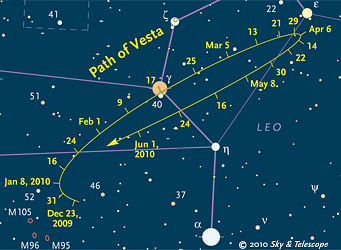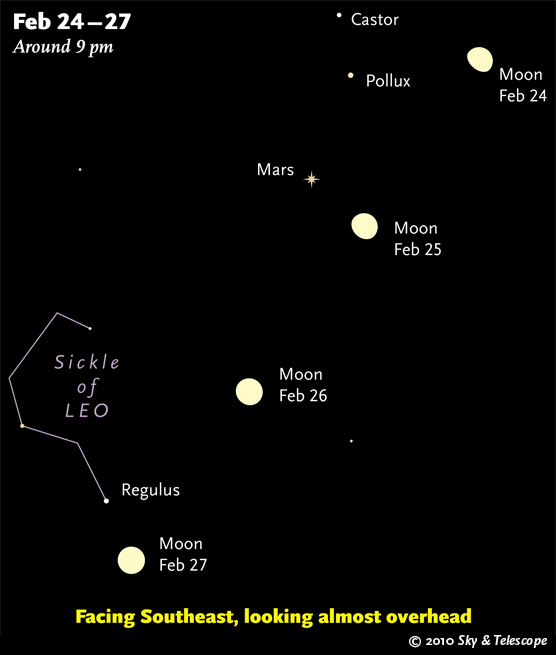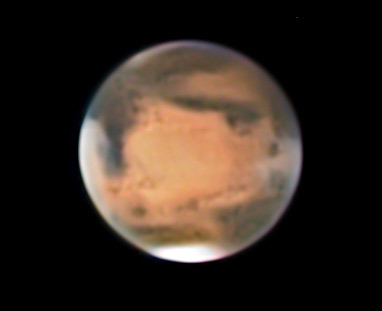Some daily events in the changing sky for February 19 – 27.
Friday, February 19

Having just threaded between Gamma and 40 Leonis, 6th-magnitude Vesta is now crossing the interior of Leo's Sickle. Click on the map for a full-page printable PDF version. (The tick marks are for 0 hours Universal Time on the dates indicated; this falls on the evening of the previous date in the time zones of the Americas.)
Tony Flanders
Saturday, February 20
Sunday, February 21
Monday, February 22
Tuesday, February 23
Wednesday, February 24

Watch the waxing gibbous Moon pass Castor and Pollux, then Mars, then Regulus. (This view is drawn for the middle of North America. European observers: move each Moon symbol a quarter of the way toward the one for the previous date. In the Far East, move it halfway. For clarity, the Moon is shown three times actual size.)
Sky & Telescope diagram
Thursday, February 25
Friday, February 26
Saturday, February 27
Want to become a better amateur astronomer? Learn your way around the constellations. They're the key to locating everything fainter and deeper to hunt with binoculars or a telescope. For an easy-to-use constellation guide covering the whole evening sky, use the big monthly map in the center of each issue of Sky & Telescope, the essential magazine of astronomy. Or download our free Getting Started in Astronomy booklet (which only has bimonthly maps).
Sky Atlas 2000.0 (the color Deluxe Edition is shown here) plots 81,312 stars to magnitude 8.5. That includes most of the stars that you can see in a good finderscope, and typically one or two stars that will fall within a 50× telescope's field of view wherever you point. About 2,700 deep-sky objects to hunt are plotted among the stars.
Alan MacRobert
Once you get a telescope, to put it to good use you'll need a detailed, large-scale sky atlas (set of charts; the standards are Sky Atlas 2000.0 or the smaller Pocket Sky Atlas) and good deep-sky guidebooks (such as Sky Atlas 2000.0 Companion by Strong and Sinnott, the more detailed and descriptive Night Sky Observer's Guide by Kepple and Sanner, or the classic Burnham's Celestial Handbook). Read how to use them effectively.
Can a computerized telescope take their place? I don't think so — not for beginners, anyway (and especially not on mounts that are less than top-quality mechanically). As Terence Dickinson and Alan Dyer say in their Backyard Astronomer's Guide, "A full appreciation of the universe cannot come without developing the skills to find things in the sky and understanding how the sky works. This knowledge comes only by spending time under the stars with star maps in hand and a curious mind." Without these, "the sky never becomes a friendly place."
More beginners' tips: "How to Start Right in Astronomy".
This Week's Planet Roundup
Mercury is lost in the glow of sunrise.
Venus (magnitude –3.9) is barely emerging from deep in the sunset. Look for it just above the west-southwest horizon about 20 minutes after sundown. Binoculars help.

Mars's north polar cap (bottom) was bright again, and clouds showed on the planet's east, west, and south limbs, when Don Parker of Coral Gables, Florida, took this image on the evening of February 11th (at 3:25 February 12th Universal Time). At left is dark Syrtis Major; just above center is long Sinus Sabaeus; and upper right of center is Sinus Meridiani. The central meridian longitude was 335°. Click on the image for larger views and more information.
Parker used a 16-inch Newtonian reflector and a Skynyx 2-0 camera. Stacked-video imagery like this can show detail on a planet much more clearly than the eye can see through the same telescope.
Donald C. Parker
Mars, still bright at magnitude –0.8, shines high in the east at dusk and is highest in the south around 10 p.m. It's in Cancer, below Pollux and Castor after dark.
In a telescope Mars is shrinking: from 13.0 to 12.4 arcseconds wide this week. Its north polar cap is again bright, but watch for it shrinking in the Martian northern-hemisphere spring during the coming weeks. Identify other surface features you see using the Mars map and observing guide in the December Sky & Telescope, page 57.
Jupiter is hidden behind the glare of the Sun.
Saturn (magnitude +0.6, in western Virgo) rises in the east around 8 p.m. and stands highest in the south around 1 or 2 a.m. In a telescope, Saturn's rings are tilted only 4.1° from edge-on to us, and they'll narrow further in the coming months.
Uranus and Neptune are behind the glare of the Sun.
Pluto is low in the southeast before dawn.
All descriptions that relate to your horizon or zenith — including the words up, down, right, and left — are written for the world's mid-northern latitudes. Descriptions that also depend on longitude (mainly Moon positions) are for North America. Eastern Standard Time (EST) equals Universal Time (also known as UT, UTC, or GMT) minus 5 hours.
To be sure to get the current Sky at a Glance, bookmark this URL:
http://SkyandTelescope.com/observing/ataglance?1=1
If pictures fail to load, refresh the page. If they still fail to load, change the 1 at the end of the URL to any other character and try again.
 0
0
Comments
You must be logged in to post a comment.